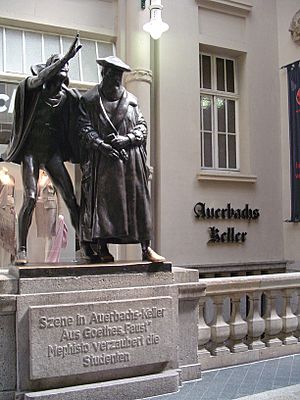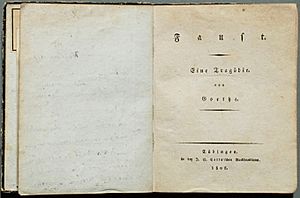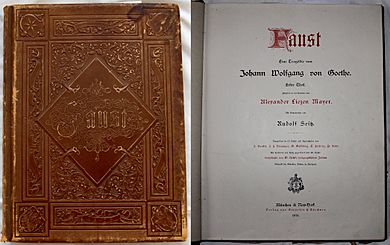Goethe's Faust facts for kids
Faust is a very famous and important play written by Johann Wolfgang von Goethe. It's a tragedy, which means it's a sad story. The play is split into two main parts: Faust, Part One and Faust, Part Two. Most of the play is written in rhyming poetry. Even though it's very long and rarely performed all at once, it's one of the most watched plays in German-speaking countries. Many people think Faust is Goethe's greatest work and one of the best pieces of German literature ever.
Contents
Faust, Part One
Faust, Part One introduces us to the main characters:
- Heinrich Faust: A very smart scholar who wants to know everything.
- Mephistopheles: The Devil, who makes a deal with Faust.
- Gretchen: A young woman who Faust falls in love with. Her full name is Margarete.
- Marthe Schwerdtlein: Gretchen's neighbor.
- Valentin: Gretchen's brother.
- Wagner: Faust's assistant.
The story of Faust, Part One begins in Heaven. Here, Mephistopheles (the Devil) makes a bet with God. Mephistopheles believes he can trick God's favorite human, Faust, away from doing good things. Faust is a scholar who is always trying to learn everything.
Next, we meet Faust in his study. He's an old scholar who feels like all his learning in science, history, and religion hasn't given him true knowledge. He tries to use magic to gain endless wisdom, but he feels like he's failing. Feeling very frustrated, he thinks about ending his life. But then, he hears the sounds of Easter celebrations nearby and decides not to.
Faust goes for a walk with his assistant, Wagner. On their way home, a stray poodle follows them. Back in Faust's study, the poodle suddenly changes into Mephistopheles! Mephistopheles is dressed like a traveling student. He tells Faust that he can't leave because of a special symbol (a pentagram) carved into Faust's doorway. Faust is surprised that Mephistopheles is bound by magical rules. Mephistopheles tricks Faust into letting him show off his powers. Faust falls asleep listening to magical songs, and Mephistopheles escapes by having rats chew away the symbol.
The next morning, Mephistopheles returns. He offers to serve Faust in this life, and in return, Faust must serve him in the afterlife. Faust agrees but is worried that this deal might lead to his downfall. So, Faust makes a special wager: if Mephistopheles can give Faust a moment on Earth that is so wonderful that Faust wishes it would last forever, then Faust will die instantly and serve the Devil in Hell. Mephistopheles accepts this bet.
Mephistopheles asks Faust to sign the pact with his blood. Faust doesn't like this, saying Mephistopheles doesn't trust his word. But in the end, Faust signs the contract with a drop of his own blood.
Faust then goes on some adventures and meets a young woman named Margaret, also called Gretchen. He is very drawn to her. With gifts of jewelry and help from Gretchen's neighbor, Marthe, Mephistopheles helps Faust get close to Gretchen. Gretchen's mother accidentally dies from a strong sleeping potion Gretchen gave her so Faust could visit. Soon after, Gretchen faces a very sad situation. Her brother, Valentin, challenges Faust and is killed by Faust and Mephistopheles. Gretchen is imprisoned. Faust tries to free her from prison, but she refuses to escape. Faust and Mephistopheles leave the dungeon. Then, voices from Heaven announce that Gretchen will be saved.
Faust, Part Two
Faust, Part Two is full of references to ancient Greek and Roman stories. In this part, the romantic story from Part One is left behind. Faust wakes up in a field of fairies and begins new adventures with different goals. This part has five acts, each with its own theme.
In the end, Faust goes to Heaven. He had technically lost his bet with Mephistopheles because he did find a moment so wonderful he wished it would last forever. However, God had won his original bet from the beginning of the play. Angels arrive and explain that anyone who keeps trying and striving can still find salvation.
How the Parts Connect
Throughout Part One, Faust is never truly satisfied. The final outcome of the story and the bets are only shown in Faust, Part Two. Part One focuses on Faust's personal life and local world. In contrast, Part Two explores a much wider world and bigger ideas.
Translations of Faust
Faust has been translated into many languages over the years. Here are some notable English translations:
- In 1821, a partial English translation of Faust (Part One) was published. Some people believe the English poet Samuel Taylor Coleridge translated it, but this is still debated.
- Another famous Romantic poet, Percy Bysshe Shelley, translated some parts of Faust in 1822.
- In 1850, Anna Swanwick released an English translation of Part One, and later Part Two in 1878. Her translations are considered very good.
- Bayard Taylor published an English translation in 1870–71 that tried to keep the original rhythm of the poetry. This translation was very popular for a long time.
- Philosopher Walter Kaufmann also translated Part One and parts of Part Two. He tried to keep Goethe's original rhythms and rhymes.
- Louis MacNeice created a shorter translation for BBC radio in 1949, which was published in 1952.
- In 1950, Boris Pasternak's Russian translation of Faust caused some controversy in the Soviet Union.
Many other people have translated Faust into English, including Peter Salm (1962), Randall Jarrell (1976), Walter Arndt (1976), Stuart Atkins (1984), David Luke (1987, 1994), Martin Greenberg (1992, 1998), John R. Williams (1999, 2007), David Constantine (2005, 2009), and Zsuzsanna Ozsváth and Frederick Turner (2020).
Faust has also been translated into other languages like French by Gérard de Nerval (1828), Japanese by Mori Ōgai (1913), and Chinese by Guo Moruo (1928, 1947).
Famous Performances
Part One Performances
- The first selected scenes of Faust, Part One were performed on May 24, 1819, at Monbijou Palace in Berlin.
- The complete Part One premiered on January 29, 1829, in Braunschweig.
- In 1885, a version of Faust was adapted for a London production starring Henry Irving as Mephistopheles.
- A 1908 production at Her Majesty's Theatre starred Henry Ainley as Faust.
- In 1960, a very successful film of a performance was made by Peter Gorski and Gustaf Gründgens, who also played Mephistopheles.
- On October 26, 2006, a long performance (4½ hours) was directed by Eimuntas Nekrošius in Italy.
Part Two Performances
- Fragments from Part Two were performed by the Piccolo Teatro di Milano in 1990.
- In 2005, Michael Thalheimer directed a performance at the Deutsches Theater in Berlin.
Entire Play Performances
- The very first time both parts of Faust were performed completely and without cuts was in 1938 at the Goetheanum in Switzerland.
- A famous performance of the entire play, directed by Peter Stein, took place at the Expo 2000 in Hanover. It lasted 21 hours with breaks!
Faust in Music and Film
Faust has inspired many musical works and films:
- Music:
* Ludwig van Beethoven wrote a song based on Faust in 1809. * Franz Schubert set a text from Faust to music in 1814, called "Gretchen am Spinnrade". * Robert Schumann created an oratorio (a large musical work) called Scenes from Goethe's Faust (1844–1853). * Hector Berlioz composed La damnation de Faust (1846). * Franz Liszt wrote his Faust Symphony in 1857. * Charles Gounod's opera Faust (1859) is very famous. * Arrigo Boito's opera Mefistofele (1868) also tells the story. * Gustav Mahler used text from Faust Part II in his Symphony No. 8 (Mahler) (1906). * Havergal Brian wrote an opera called "Faust" in 1955–56. * Randy Newman created a musical called Faust in 1993. * Rudolf Volz created a Rock Opera Faust in 1997 using Goethe's original words. * The American metal band Kamelot based their albums Epica (2003) and The Black Halo (2005) on Faust. * The American band Agalloch's EP Faustian Echoes is directly based on Goethe's work.
- Film:
* F. W. Murnau's silent film Faust (1926) is a classic. * Peter Gorski directed a film of the 1960 stage performance, also called Faust. * Jan Švankmajer made a film called Faust in 1994. * Alexander Sokurov directed a film version of Faust in 2011. * Philipp Humm's modern art film The Last Faust (2019) is the first film to cover both parts of Goethe's Faust.
See also
 In Spanish: Fausto (Goethe) para niños
In Spanish: Fausto (Goethe) para niños







